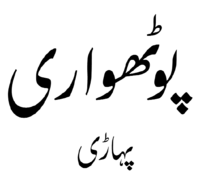Pahari-Pothwari
Pahari-Pothwari is a dialect of Punjabi of Lahnda group,[b] spoken on the Pothohar Plateau in the far north of Punjab, Pakistan, as well as in most of Pakistan-administered Azad Kashmir and in western border areas of Indian-occupied Jammu and Kashmir, is known by a variety of names, the most common of which are Pahari (English: /pəˈhɑːri/;[1] an ambiguous name also applied to other unrelated languages of India), and Pothwari (or Pothohari).
| Pahari-Pothwari | |
|---|---|
| پوٹھواری, پہاڑی Poṭhwārī, Pahāṛī | |
 | |
| Native to | Pakistan |
| Region | Pothohar region of Punjab, Azad Kashmir and western parts of Jammu and Kashmir, other parts of India including Punjab and Haryana (by partition refugees and descendants) |
| Ethnicity | Punjabis |
Native speakers | several million[a] |
| Shahmukhi | |
| Language codes | |
| ISO 639-3 | phr |
| Glottolog | paha1251 Pahari Potwari |
The language is transitional between Hindko and Majhi and is mutually intelligible with both.[2] There have been efforts at cultivation as a literary language,[3] although a local standard has not been established yet.[4] The Shahmukhi script is used to write the language, such as in the works of Punjabi poet Mian Muhammad Bakhsh.
Grierson in his early 20th-century Linguistic Survey of India assigned it to a so-called "Northern cluster" of Lahnda (Western Punjabi), but this classification, as well as the validity of the Lahnda grouping in this case, have been called into question.[5] In a sense both Pothwari, as well as other Lahnda varieties, and Standard Punjabi are "dialects" of a "Greater Punjabi" macrolanguage.[6]
Due to effects of dominant languages in Pakistani media like Standard Punjabi and English and religious impact of Arabic and Persian, Pahari-Pothwari like other regional varieties of Pakistan are continuously expanding its vocabulary base with loan words.[7]
Places
changeWithin Pakistan, it is spoken in the Pothohar Plateau and Azad Kashmir and overlaps between these two regions.[8]: 46
Numbers
changeThe numbering in Pahari-Pothwari is similar to that of other Punjabi dialects and varieties. Pahari-Pothwari uses trai for three, which is also found in some forms of Majhi and Hindko.[9]
- ikk
- do
- trai
- chār
- panj
- chae
- satt
- att
- nou
- das
Notes
change- ↑ Baart (2003, p. 10) provides an estimate of 3.8 million, presumably for the population in Pakistan alone. Lothers & Lothers (2010, p. 9) estimate the Pakistani population at well over 2.5 million and the UK diaspora at over 0.5 million. The population in India is reported in Ethnologue (2017) to be about 1 million as of 2000.
- ↑ There is no consensus among linguists or Pahari-Pothwari speakers in terms of its status as a dialect of Punjabi or a separate language entirely. For the difficulties in assigning the labels "language" and "dialect", see Shackle (1979) for Punjabi and Masica (1991, pp. 23–27) for Indo-Aryan generally.
References
change- ↑ Template:Cite OED
- ↑ Hussain, Qandeel (2020-12-31). "Punjabi (India and Pakistan) – Language Snapshot". Language Documentation and Description. 19: 144. doi:10.25894/ldd71. Archived from the original on 2023-04-09. Retrieved 2024-11-04.
- ↑ Masica 1991, p. 440.
- ↑ Shackle 1983, p. 183.
- ↑ Shackle 1979, p. 201: Pothohari "is often so close to Panjabi that any attempt to maintain the Lahndi scheme ought probably to reckon it as 'Lahndi merging into Panjabi'."
- ↑ Rahman, Tariq (1995-01-01). "The Siraiki Movement in Pakistan". Language Problems and Language Planning. 19 (1): 16. doi:10.1075/lplp.19.1.01rah. ISSN 0272-2690.
- ↑ Shams, Shammim Ara (2020). "The Impact of Dominant Languages on Regional Languages: A Case Study of English, Urdu and Shina". Pakistan Social Sciences Review. 4 (III): 1092–1106. doi:10.35484/pssr.2020(4-III)79.
- ↑ Javaid, Umbreen. 2004. Saraiki political movement: its impact in south Punjab. Journal of Research (Humanities), 40(2): 55–65. Lahore: Faculty of Arts and Humanities, University of the Punjab. (This PDF contains multiple articles from the same issue.)
- ↑ Rahman, Tariq. 1997. Language and Ethnicity in Pakistan. Asian Survey, 1997 Sep., 37(9):833-839.